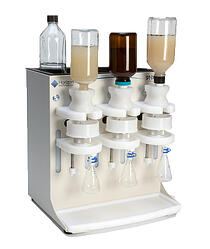It is easier to understand something when you know what the actual word means. A thermistor is a portmanteau (yes, sometimes I do pay attention to linguistics) of the words thermal and resistor. This means that when a thermistor is heated, its resistance is either increased or decreased based on the properties of that particular thermistor. This property makes it very useful for many different applications all over the world. But thermistors are most useful, at least from my perspective, when they’re used in automated solid-phase extraction systems.
Personally, I’m delighted to be using thermistors on the Biotage® Horizon 4790 and Biotage® Horizon 5000 extraction systems in my lab; however, I should point out that these systems use thermistors in different ways. While those differences may seem trivial, I feel as though I should point them out – not just because I find them interesting, but because it’s useful to know if you ever find yourself troubleshooting
The 4790 has two thermistors that are both used toward the beginning of the extraction. The top thermistor is used for the pre-wet step and the bottom one is used for the sample loading step.
During the pre-wet step, the top thermistor stays warm until solvent is delivered to its intended level inside the disk holder. The thermistor then cools and signals the instrument to stop delivering the pre-wet solvent. If that signal gets interrupted – or fails to be delivered in the first place – then the instrument won’t prevent the loss of the sample. The bottom thermistor does the opposite during the sample loading phase. It is submerged and stays cool while the sample is present, but once the sample is finished it warms back up and tells the instrument to move on to the next step.
The 5000 has two thermistors that do different tasks. The largest difference between the 4790 and 5000 is the fact that the top thermistor for the 5000 functions as an overflow sensor. This sensor is only active during the sample loading phase of the run. If it is ever submerged, the thermistor cools, signaling the water inlet valve to close, which prevents the loss of your sample. The lower thermistor is the same as that on the 4790 where the thermistor will warm after the sample is finished processing, telling the instrument to proceed to the next step.
that the top thermistor for the 5000 functions as an overflow sensor. This sensor is only active during the sample loading phase of the run. If it is ever submerged, the thermistor cools, signaling the water inlet valve to close, which prevents the loss of your sample. The lower thermistor is the same as that on the 4790 where the thermistor will warm after the sample is finished processing, telling the instrument to proceed to the next step.
These thermistors work really nicely and, for most methods, you can follow the standard (or recommended) settings for adjusting their height. However, I should point out that there are times when you may need to adjust them. If you are processing particularly dirty samples and have to add some sort of filter aid, you can imagine that the height of your disk will change. This would be a case where you should raise the height of your thermistors to prevent them from being constantly submerged. Remember, they produce signals when the temperature of the thermistor changes. If your thermistor cools off too quickly, you may not use as much pre-wet solvent as you should. Conversely, if your thermistor never warms up (because it’s constantly submerged in your sample), your extractor will never get the signal that your sample has loaded, and it will never proceed to the next step. I would also suggest making sure they stay clean!
For more application and technical tips, click the read more button below.

 Organic Workflow
Organic Workflow Peptide Workflow
Peptide Workflow Scale-Up Flash Purification
Scale-Up Flash Purification  Sample Preparation
Sample Preparation Biomolecule Purification
Biomolecule Purification Oligo synthesis
Oligo synthesis Scavengers and Reagents
Scavengers and Reagents Service & Support
Service & Support Accessories & Spare parts
Accessories & Spare parts Investors
Investors Reports & News
Reports & News The Share
The Share Corporate Governance
Corporate Governance Calendar
Calendar Sustainability
Sustainability Our Offering
Our Offering Our History
Our History Our Locations
Our Locations Leadership
Leadership
